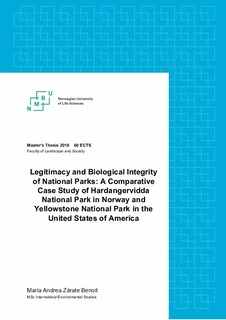| dc.contributor.advisor | Vedeld, Pål Olav | |
| dc.contributor.author | Zarate Benoit, Maria Andrea | |
| dc.date.accessioned | 2019-07-05T08:17:30Z | |
| dc.date.available | 2019-07-05T08:17:30Z | |
| dc.date.issued | 2019 | |
| dc.identifier.uri | http://hdl.handle.net/11250/2603536 | |
| dc.description | A comparative case study between the environmental governance systems of Yellowstone National Park and Hardangervidda National Park and their perceived results in biological integrity and public legitimacy. | nb_NO |
| dc.description.abstract | The United States of America and Norway are two countries with outstanding natural beauty and international high standards of human development. Yellowstone National Park (YNP) and Hardangervidda National Park (HNP) are relevant because of their natural assets. These two parks also represent the academic debate between community conservation and protectionist/fortress conservation; and between anthropocentric and ecocentric values respectively—for the purpose of resource and biodiversity conservation. This study focused on comparing the perceived outcomes produced by the parks in biological integrity and public legitimacy. The study looked at these two drastically different conservation approaches in different contexts to learn from their successes and shortcomings. The findings were based on secondary data sources and to a lesser degree on primary data. On this particular case study it was found that, as anticipated, community conservation appears to produce higher public legitimacy, and protectionist conservation appears to produce higher biological integrity. Interestingly, the difference in the outcomes did not seem to be drastic, which could indicate that bridging these two conservation approaches might not be an impossible deed. In addition, some uncharacteristic qualities of their respective conservation approach were found in each park. Infrastructure and technology in the parks proved to have different effects on the wildlife, suggesting that context, regulations, and the role played by people and the infrastructure, might determine whether these prove to be neutral, positive or detrimental to the ecosystem. The context in which the conservation method is applied, could also matter more for reaching high levels of biological integrity and high public legitimacy, than the conservation method itself. This study highlighted how a protectionist conservation approach (YNP) could potentially borrow from conservation approach methods (HNP), and vice versa, to improve their respective shortcomings. | nb_NO |
| dc.language.iso | eng | nb_NO |
| dc.publisher | Norwegian University of Life Sciences, Ås | nb_NO |
| dc.rights | Attribution-NonCommercial-NoDerivatives 4.0 Internasjonal | * |
| dc.rights.uri | http://creativecommons.org/licenses/by-nc-nd/4.0/deed.no | * |
| dc.subject | National Park | nb_NO |
| dc.subject | Biodiversity | nb_NO |
| dc.subject | Nature conservation | nb_NO |
| dc.subject | Protected areas | nb_NO |
| dc.subject | Resource management | nb_NO |
| dc.subject | Environmental governance | nb_NO |
| dc.title | Legitimacy and biological integrity of national parks : a comparative case study of Hardangervidda National Park in Norway and Yellowstone National Park in the United States of America | nb_NO |
| dc.type | Master thesis | nb_NO |
| dc.description.version | submittedVersion | nb_NO |
| dc.subject.nsi | VDP::Social science: 200 | nb_NO |
| dc.description.localcode | M-IES | nb_NO |

